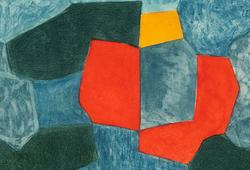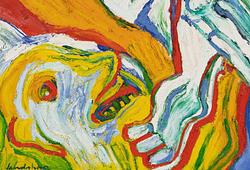Olle Hjortzberg
Yellow roses in a silver vase
Signed Olle Hjortzberg and dated 1951. Canvas 65 x 54 cm.
Provenance
Fritzes Kungliga Hovbokhandel, Stockholm.
Stockholms Auktionsverk, Stora Kvalitén, 25 - 27 May 2005, lot 2077.
Private Collection, Sweden.
More information
An event of considerable importance for Hjortzberg's artistic career was his encounter with the Byzantine mosaics in Ravenna. It was also as a large-format decorative painter that Hjortzberg primarily came to work, particularly in the adornment of ecclesiastical interiors. In 1908, Hjortzberg was elected a member of the Royal Academy of Fine Arts, and the following year he was appointed as a teacher of decorative art. In 1912, he received a professorship in drawing, a position he held until 1937. Between 1937 and 1939, he served as a professor of painting. Concurrently, he also worked as a teacher at the school of decorative arts and served as chairman of the Swedish Society of Crafts and Design from 1926 to 1931. From 1943 onward, Hjortzberg was the president of the Royal Academy of Fine Arts.
Among the artist’s more renowned works as a mural painter are the paintings in Engelbrekt Church, begun in 1913, and the wall paintings in Linköping Grammar School from 1916. Both of these decorative projects exhibit Hjortzberg’s characteristic elements of lush, Art Nouveau-inspired vegetal ornamentation. Hjortzberg was also influenced by the stylistic ideals of the English Arts and Crafts movement, which he frequently employed in the many posters he designed as an early pioneer in this field. A celebrated example is the poster for the 1912 Stockholm Olympic Games. As a counterpoint to the stylistically constrained imagery in both mural painting and illustration, Hjortzberg, in his later years, turned to a new visual language.
In numerous watercolors and oil paintings, Hjortzberg expressed his talent through a series of floral still lifes. In a fresh and unrestricted realistic style, Hjortzberg utilized the full spectrum of the palette to capture the eternal beauty that can only be found in nature.










































